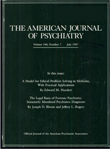Identifying the depressive border of the borderline personality disorder
Abstract
The relationship between depression and borderline disorder is unclear. Using standardized observer- and subject-rated scales for depression, the authors compared patients satisfying DSM-III criteria for borderline personality disorder and dysthymic disorder. The two groups did not differ on depression as defined by the scales; however, there was a substantial intergroup difference on certain characteristics of the depression spectrum thought empirically to be associated more often with the borderline patient. The depth and quality of the depression of the borderline patient may largely overlap with that of the dysthymic patient, but it also possesses features that make it qualitatively distinct.
Access content
To read the fulltext, please use one of the options below to sign in or purchase access.- Personal login
- Institutional Login
- Sign in via OpenAthens
- Register for access
-
Please login/register if you wish to pair your device and check access availability.
Not a subscriber?
PsychiatryOnline subscription options offer access to the DSM-5 library, books, journals, CME, and patient resources. This all-in-one virtual library provides psychiatrists and mental health professionals with key resources for diagnosis, treatment, research, and professional development.
Need more help? PsychiatryOnline Customer Service may be reached by emailing [email protected] or by calling 800-368-5777 (in the U.S.) or 703-907-7322 (outside the U.S.).



